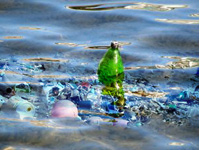A Sea of Garbage
 GLOBE-Net - Many businesses are up in arms over the decision of the City of Toronto that merchants must charge consumers five cents for each plastic shopping bag as of June 1st, 2009. The measure is designed to reduce the amount of plastic that ends up in city landfills.
GLOBE-Net - Many businesses are up in arms over the decision of the City of Toronto that merchants must charge consumers five cents for each plastic shopping bag as of June 1st, 2009. The measure is designed to reduce the amount of plastic that ends up in city landfills. It would be nice to remind everyone that plastics do not just end up in landfills or pollute city streets. They also twirl inside massive ocean gyres that draw in debris from the coasts without leaving any chance of escape.
The most well-known is the Great Pacific Garbage Patch that floats inside the North Pacific Gyre between San Francisco and Japan. This massive trash vortex, roughly the size of Texas, consists of an estimated 100 million tons of plastic debris continuously powered by currents in a clockwise fashion.
Toothbrushes, umbrella handles, toys and soda bottles make up some of the material floating on the surface of the water. Most of the pollution is made up, however, of tiny pieces of plastic resting just below the surface, too tough for consumption by bacteria. Greenpeace estimates that there are one million items floating inside each square kilometer of the Great Pacific Garbage Patch. The result is a sea of trash that harms marine life.
“It’s a dispersed congregation of our debris from civilization, mostly plastic,” explains Charles Moore, founder of the Agalita Marine Research Foundation during an interview on National Public Radio. “It’s not a sheet so much as a bunch of little bits sprinkled over the surface of the water.”
These bits get into the food chain. Plastic polymers, it turns out, are sponges for DDT, PCBs and other oily pollutants. When sea organisms ingest the toxins and fish eat them in turn, the pollutants eventually end up on dinner plates at fine dining establishments.
Debris also causes death to marine life by drowning, suffocation, strangulation, and starvation when digestive tracts are blocked by say, a bottle cap. Even discarded fishing nets can continue to trap and catch fish even when they are no longer in use, says Greenpeace. Each year, trash at sea kills an estimated 100,000 marine mammals in the North Pacific.

Most plastics are not biodegradable. Instead, sunlight breaks them down into tiny pieces that either float on the surface or are dragged by underwater currents toward the ocean gyres. It takes up to one year for plastics from Japan to reach the Great Pacific Garbage Patch and up to five years for debris from the United States, says Charles Moore.
And debris found at sea grows exponentially. Near Japan, the amount of plastic garbage expands by a factor of 10 every two to five years. “The consequences of putting that much stuff shading the surface of the ocean is unknown,” says Moore in his NPR interview. “We don’t know how it’s going to effect the sequestration of carbon dioxide from the atmosphere.”
Scientists estimate that 80 percent of marine debris originates from land sources and the remaining 20 percent come from ships that throw goods overboard. A number of international and national initiatives have been put in place to reduce those figures. One is the International Convention for the Prevention of Pollution from ships (MARPOL) meant to stop ships from dumping garbage and plastics at sea. It has had little effect since its introduction in 1988.
Some have argued that ships could sail with massive nets to clean up the Great Pacific Garbage Patch, but the scale of the pollution is so massive that an entire navy fleet could not clean up a mess that has grown tenfold every decade since the 1950s. And let us not forget that most of these plastics originate in wealthy countries. When less developed nations become wealthy themselves, their consumers also will dump their plastics into the oceans.
It seems that the sea can only be protected by encouraging the public to reduce its own consumption. The decision by Toronto’s city council to charge for the use of plastic bags in stores is a step in the right direction.
If a five-cent a bag charge modifies consumer behavior, even in a small way, the world’s oceans will be better off.
You can return to the main Market News page, or press the Back button on your browser.


